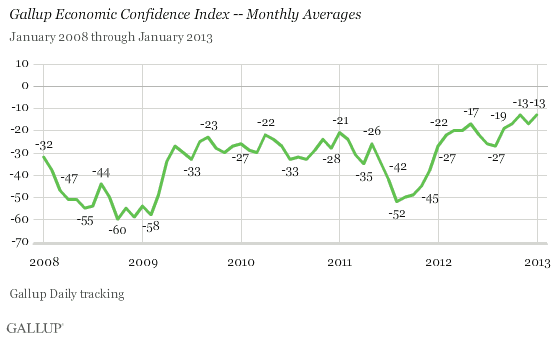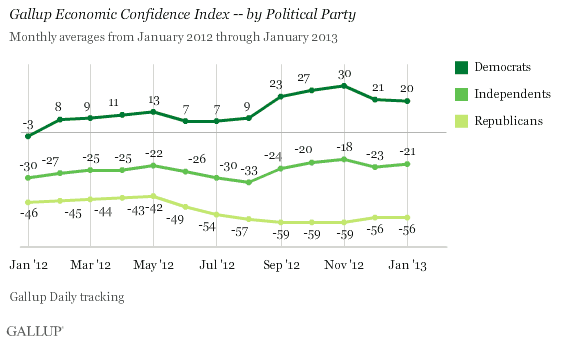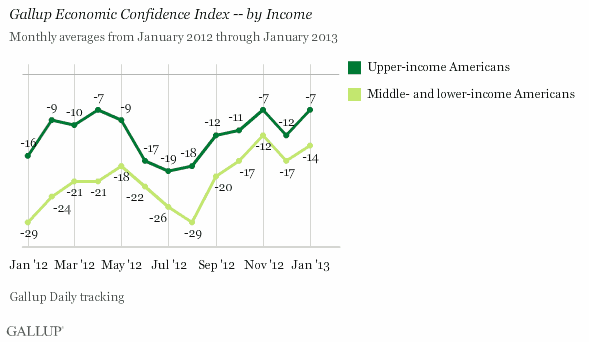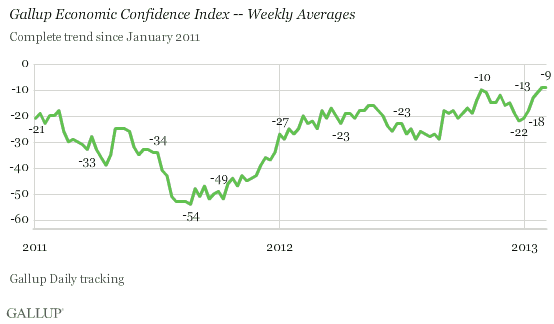WASHINGTON, D.C. -- U.S. Economic Confidence improved to -13 in January, matching the five-year monthly high set in November 2012. Economic confidence improved steadily from September to November before falling back to -17 after the presidential election, but has now returned to its pre-election peak.

These results are based on Gallup Daily tracking interviews, conducted by landline and cellphone, with more than 14,000 Americans from Jan. 2-31.
Democrats More Optimistic Than Independents, Republicans
Democrats remain most optimistic among consumers by political party; their January Economic Confidence Index score is +20, compared with much more negative confidence scores among independents (-21) and Republicans (-56). These partisan differences are not a new phenomenon; Americans who identify with the party in the White House are usually significantly more positive than those who do not. The gap between partisan groups expanded in the fall of last year and remains larger than it was in the first half of 2012.

Upper-Income More Optimistic Than Middle- and Lower-Income Americans
Upper-income Americans continue to be more confident in the U.S. economy, at -7, than their middle- and lower-income counterparts, at -14. Confidence peaked among both groups in November, before turning downward in December and then recovering to essentially peak levels in January.

Weekly Economic Confidence at Five Year High
Monthly averages for economic confidence tend to mask movements in Americans' perceptions that are better reflected by weekly averages. On a weekly basis, economic confidence reached a five-year peak at -9 for the week ending Jan. 27 and remained at that level during the week ending Feb. 3. Confidence hit -10 in the week ending Nov. 4, just prior to the presidential election, and then fell post-election before returning to peak levels during the past two weeks.

Implications
While monthly averages show economic confidence in January matching the five-year peak it first reached in November, weekly averages show even more positive momentum. This increase in consumer confidence seems consistent with the surging equity markets, now at five-year highs, perceptions of an improving housing market, and the deferral of political confrontation over the federal debt ceiling. Evidently, these factors are -- at least temporarily -- outweighing consumer concerns over the payroll tax increase and increasing gas prices.
Gallup's weekly economic confidence findings, which show lower economic confidence early in January and an improvement later in the month, are also consistent with the preliminary and final findings of the Conference Board's Consumer Confidence Index and the Thomson Reuters/University of Michigan Consumer Sentiment Index.
It appears the U.S. Federal Reserve and other central banks around the world have been successful at sending the equity markets higher as they pump money into the world economy. Economic confidence data suggest these efforts and the avoidance of potential political battles are doing the same for consumer confidence. The question going forward is whether this improving economic confidence will translate into increased economic growth over the weeks and months ahead.
Gallup.com reports results from these indexes in daily, weekly, and monthly averages and in Gallup.com stories. Complete trend data are always available to view and export in the following charts:
Daily: Employment, Economic Confidence, Job Creation, Consumer Spending
Weekly: Employment, Economic Confidence, Job Creation, Consumer Spending
Read more about Gallup's economic measures.
View our economic release schedule.
Survey Methods
Results are based on telephone interviews conducted as part of the Gallup Daily tracking survey Jan. 2-31, 2013, with a random sample of 14,759 adults, aged 18 and older, living in all 50 U.S. states and the District of Columbia, selected using random-digit-dial sampling.
For results based on the total sample of national adults, one can say with 95% confidence that the margin of sampling error is ±1 percentage point.
Interviews are conducted with respondents on landline telephones and cellular phones, with interviews conducted in Spanish for respondents who are primarily Spanish-speaking. Each sample of national adults includes a minimum quota of 50% cell phone respondents and 50% landline respondents, with additional minimum quotas by region. Landline telephone numbers are chosen at random among listed telephone numbers. Cell phones numbers are selected using random digit dial methods. Landline respondents are chosen at random within each household on the basis of which member had the most recent birthday.
Samples are weighted to correct for unequal selection probability, nonresponse, and double coverage of landline and cell users in the two sampling frames. They are also weighted to match the national demographics of gender, age, race, Hispanic ethnicity, education, region, population density, and phone status (cellphone only/landline only/both, cellphone mostly, and having an unlisted landline number). Demographic weighting targets are based on the March 2012 Current Population Survey figures for the aged 18 and older U.S. population. Phone status targets are based on the July-December 2011 National Health Interview Survey. Population density targets are based on the 2010 census. All reported margins of sampling error include the computed design effects for weighting.
In addition to sampling error, question wording and practical difficulties in conducting surveys can introduce error or bias into the findings of public opinion polls.
For more details on Gallup's polling methodology, visit www.gallup.com.
